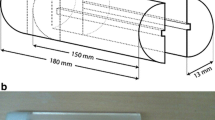Abstract
The use of Valencia applicators across irregular surface contours results in significant dose heterogeneities at the prescription depth. Investigations were carried out using extended source surface distances (standoff) to reduce these dose heterogeneities. Relative output factors were measured with a Roos chamber and Gafchromic EBT3 film was used to measure profiles and percentage depth doses at numerous standoff distances. The use of 20 mm standoff was found to reduce the relative difference in delivered dose across a 4 mm change in surface contour by 10.6 % for the H2 applicator and 10.0 % for the H3 applicator. The radiation became more penetrating with standoff and the field size larger, as expected. The results show that standoff can be used with the Valencia applicator to reduce dose heterogeneities across changes in surface contour.







Similar content being viewed by others
References
Granero D, Pérez-Calatayud J, Jimeno J et al (2008) Design and evaluation of a HDR skin applicator with flattening filter. Med Phys 35:495–503
Pérez-Calatayud J, Granero D, Ballester F et al (2005) A dosimetric study of the Leipzig applicators. Int J Rad Oncol Biol Phys 62:579–584
Niu H, His WC, Chu JCH et al (2004) Dosimetric characteristics of the Leipzig surface applicators used in the high dose rate brachy radiotherapy. Med Phys 31:3372–3377
Arthur G, Collett N, Lee C et al (2008) Dosimetric investigation of a new skin applicator. Australas Phys Eng Sci Med 31(4):480
Lliso F, Granero D, Pérez-Calatayud J et al (2011) Dosimetric evaluation of internal shielding in a high dose rate skin applicator. J Contemp Brachyther 3(1):32–35
Stewart A (2008) Radiotherapy of complex superficial targets: modality choices. Nowotwory J Oncol 58(2):58e–61e
Ming XuM, Sethi A, Glasgow G (2009) Dosimetry of small circular fields for 6-MeV electron beams. Med Dosim 34(1):51–56
Ferreira BC, Lopes MC, Capela M (2009) Evaluation of an Epson flatbed scanner to read Gafchromic EBT films for radiation dosimetry. Phys Med Biol 54:1073–1085
Childress N, Vantreese R and Rosen I (2013) DoseLab 4.11 An open source dose comparison software package for medical physicists. http://sourceforge.net/projects/doselab/
Butson MJ, Cheung T, Yu PKN (2006) Scanning orientation effects on Gafchromic EBT film dosimetry. Australas Phys Eng Sci Med 29(3):281–284
Fiandra C, Ricardi U, Ragona R et al (2006) Clinical use of EBT model Gafchromic™ film in radiotherapy. Med Phys 33(11):4314–4319
Shima K, Takeoka K, Saitoh Y et al (2012) Analysis of post-exposure density growth in radiochromic film with respect to the radiation dose. J Radiat Res 53:301–305
Bevelacqua JJ (2009) Contemporary health physics: problems and solutions, 2nd edn. Wiley-VCH, Weinheim, pp 565–569
Mayles P, Nahum A, Rosenwald JC (2007) Handbook of radiotherapy physics, theory and practice. Taylor & Francis, Oxfordshire, p 447
Acknowledgments
The support for this work by Nucletron is gratefully acknowledged.
Author information
Authors and Affiliations
Corresponding author
Rights and permissions
About this article
Cite this article
Byrne, M., Arthur, G. The use of Valencia applicators at extended source surface distances for irregular surface contours. Australas Phys Eng Sci Med 37, 115–120 (2014). https://doi.org/10.1007/s13246-014-0251-3
Received:
Accepted:
Published:
Issue Date:
DOI: https://doi.org/10.1007/s13246-014-0251-3




